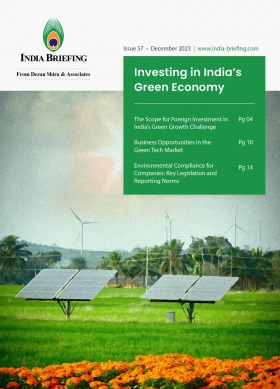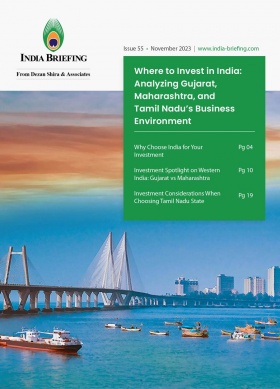An Introduction to Doing Business in India 2024: New Publication Out Now
An Introduction to Doing Business in India 2024, the latest publication from Dezan Shira & Associates, is out now and available as a complimentary download on the Asia Briefing Publication Store.
In this guide
Welcome to the 2024 edition of our Introduction to Doing Business in India guide.
As India’s economic prowess captures global attention and the country is poised to become the world’s third largest economy by 2030, this guide will assist businesses seeking to navigate this vibrant market. India’s GDP growth is predicted to reach 6.5 percent in 2024-25, and hit 7 percent in 2026. Amid another year of global turmoil underpinned by war and conflict and uneven post-pandemic
recovery, India’s economy has stood out as a bright spot. Anchored by political stability and a continued focus on business facilitation, 2023 saw key industries getting a boost through PLI schemes and competitive state-wise industrial policies.
The G20 Summit was also successfully hosted in the country and presented the Indian market as a forward-looking base that can serve as a key point in global supply chains. The semiconductor industry and green sector are two areas where India has engaged with key global partners for support in terms of investments and technology transfer. As these evolve, they will support India’s sustainable development targets and moving up the industrial value chain.
Designed to introduce the fundamentals of investing in India, this publication is compiled by the experts at Dezan Shira & Associates, a specialist practice providing corporate establishment, business advisory, tax advisory and compliance, accounting, payroll, due diligence, and financial review services to multinationals investing in emerging Asia.
Doing Business in India 2024 covers the following:
- Corporate establishment
- India’s investment climate
- Tax, audit, and accounting
- Human resources and payroll
- Trade policy
Special focus: India is the Fastest Growing Economy Among G20 Economies
India’s economic trajectory for 2024 presents a compelling narrative, positioning the country as the fastest-growing G20 economy. A GDP growth of 6.5 percent is projected for the fiscal year 2024-25, reaching 7 percent in 2026. S&P Global predicts India to overtake China’s growth forecast, and even conservative estimates by the International Monetary Fund (IMF) suggest that India could become the world’s third-largest economy by 2027, surpassing Japan and Germany, with a GDP exceeding US$5 trillion.
This year, India’s stock market rose to become the seventh largest with a market capitalization of US$3.989 trillion. India’s Nifty 50 index hit a new high, up 16 percent, surpassing Hong Kong’s
Hang Seng index (US$3.984 trillion) at the end of November. While banking, healthcare, and energy are predicted to be high performing sectors in 2024, consumer goods, utilities, and
chemicals are expected to lag.
India is now reaching the pivotal phase of the S-curve, characterized by a significant acceleration in urbanization, industrialization, household incomes, and energy consumption. This phase
typically spans several decades, marked by rapid growth in these areas.
Factors driving India’s optimistic economic outlook for 2024
- Robust economic fundamentals: India’s GDP of US$3.75 trillion establishes it as the fifth-largest global economy. The Reserve Bank of India’s projection of reaching US$5 trillion by 2027 indicates a sustained upward trend. S&P Global Ratings has forecasted that India’s economic growth prospects will remain robust in the medium term, with GDP expected to expand at an annual rate of 6-7.1 percent during the fiscal years 2024-2026.
- Thriving industrial manufacturing sector: The industrial manufacturing sector has witnessed substantial growth, attracting several global manufacturing and technology giants. State industrial policies and incentives, coupled with successful production-linked incentive (PLI) schemes, have revitalized manufacturing, with notable success stories like Apple and Foxconn.
- Infrastructure development and connectivity: Government commitment to infrastructure development, including significant investments in logistics and construction, positions India as a key player in global supply chains. Strategic initiatives to reduce logistics costs and focus on regional connectivity contribute to sustained economic growth.
- Diversification beyond China: India’s manufacturing programs align with the ‘China Plus One’ strategy, attracting investments from companies seeking to diversify production beyond China. Leading multinationals have set up local subsidiaries as well as contracted electronics manufacturing services to Indian firms.
- Ease of doing business: Bureaucracy reforms, such as digitizing regulatory processes, contribute to a business-friendly environment.
- Resilient trade and services export sectors: Despite challenges in attracting foreign direct investment amid global uncertainties, India’s trade and services export sectors remain robust. Services exports are expected to reach US$400 billion by the end of 2023-24, showcasing the nation’s resilience amid geopolitical shocks. India is also pursuing full free trade agreements with key markets like the UK, Australia, GCC, and the EU.
- Positive growth areas: Key growth areas for India in 2024 include digitalization, sustainable production and infrastructure, trade facilitation, expanding manufacturing capacity, semiconductors and technology R&D, and growth in the financial sector.
- Young demographic advantage: India’s status as the most populous country globally, with a median age of 28.2 years, contributes to economic vibrancy. The recovery in domestic demand, particularly in private consumption and household spending, supports business expansion plans.
- Rise of non-metropolitan hubs: Talent availability and connectivity linkages with metropolitan majors has resulted in the rise of Tier-2 and Tier-3 cities in India (so defined by population parameters), which are allowing service and manufacturing multinational companies to set up in more cost-effective destinations. This has had positive spillover effects on regional economies.
- Consumer market: India is the world’s fourth largest retail market and the 16th-ranked country on the 2023 FDI Confidence Index. Discretionary spending power is on the rise, with the average per capita income in India surpassing US$2000 and projected to exceed US$12,000 by 2047. The substantial middle class and underserved consumer base in non-metropolitan cities attract the interest of several international retail giants seeking expansion into new markets. Branded products, such as apparel, cosmetics, jewelry, footwear, watches, food and beverage (F&B), and furnishings, are gaining popularity and becoming essential lifestyle items for both business and leisure purposes.
- Emerging industries and commitment to sustainability: India’s focus on emerging industries like healthcare, fintech, renewable energy, electric vehicles, IT, and semiconductor manufacturing aligns with global trends. Commitment to decarbonization and achieving 500 GW renewables capacity by 2030 reflects a forward-looking approach.
- Corporate sustainability and ESG considerations: Sustainability and environmental, social, and governance (ESG) considerations are gaining prominence in the corporate sector and contribute to responsible and ethical business practices. Green tech skills are becoming essential, creating jobs and fostering growth in the green industry. Currently, ‘Business Responsibility and Sustainability Reporting by listed entities’ (BRSR) is applicable to the top 1000 listed entities in India (by market capitalization). Further, mandatory assurance of critical parameters—49 core indicators identified from BRSR—under the BRSR Core, is applicable to the top 150 listed companies in India as of FY 2023-24 and top 250 listed companies as of FY 2024-25.
- Education reforms and skilling initiatives: Policy emphasis on education reforms and skilling initiatives addresses the changing nature of jobs, preparing the large young demographic cohort for future challenges.
- State stability and investment opportunities: While the 2024 general elections to the federal government introduce uncertainties, states with local governments not going for fresh elections like Karnataka, Tamil Nadu, Telangana, Uttar Pradesh, Gujarat, and Maharashtra present attractive investment opportunities. Foreign companies are encouraged to consult local experts to assess if their business lines align with promoted economic activity in state industrial policies and thereby tap key fiscal incentives.
- Hot sectors for India in 2024: Emerging industries like battery energy storage, green hydrogen, biotechnology, clean mobility, food processing, AVGC (animation, visual effects, gaming, comics), and semiconductor chip manufacturing offer investment-led growth opportunities. Given India’s commitment to decarbonization and achieving 500 GW renewables capacity by 2030, allied sectors will seek foreign capital and expertise. Overall, key industries beckoning foreign investors in India in 2024 include healthcare and insurance, fintech, renewable energy and climate tech, electric vehicles and automobiles, IT and services, real estate and infrastructure, fast-moving consumer goods (FMCG), logistics, R&D, global capability centers, and artificial intelligence (AI).
About Us
India Briefing is produced by Dezan Shira & Associates. The firm assists foreign investors throughout Asia from offices across the world, including in Delhi and Mumbai. Readers may write to india@dezshira.com for more support on doing business in India.
We also maintain offices or have alliance partners assisting foreign investors in Indonesia, Singapore, Vietnam, Philippines, Malaysia, Thailand, Italy, Germany, and the United States, in addition to practices in Bangladesh and Russia.
- Previous Article India’s Surat Diamond Bourse: A Game-Changing Hub for Global Diamond Trade
- Next Article Investing in India’s Telangana State: A Quick Guide









